The banding or ringing of birds for scientific research purposes has been carried out for many decades. I described the banding of seabirds in a previous post on this blog.
I have been involved in bird banding research for 25 years. I’ve had a hand in multiple projects, which often included travel to some incredible places around Australia. I have trained many other banders, including at short intensive courses. My experience and capacity for teaching led to me being invited to work on a significant project back in 2010-11.
The Australian Bird and Bat Banding Scheme (ABBBS) manages the collation of information on threatened and migratory bird and bat species. The scheme administers bander qualifications and authorises banding projects.
In 2008, the ABBBS received project funding from our international aid agency, AUSAid, to assist the Indonesian Government in the establishment of regulatory mechanisms relating to wild bird research.
In particular, the project aimed to improve and build Indonesia’s capacity to monitor Avian Influenza in wild bird populations, by humane capture and individual marking of sampled birds.
A major component of the project was the training of ornithological researchers in the capture, mark and release of wild birds. Those qualified banders would then train new banders in the new Indonesian Bird Banding Scheme.
The key tasks for the trips were to:
- instil an awareness of the methods we use for bird research;
- help trainees become proficient in the practical aspects of bird banding operations;
- help trainees become confident in the extraction, handling and processing of wild birds;
- ensure a regard for the welfare of wild birds;
- ensure that data was collected accurately; and
- facilitate the design and implementation of research projects.
The manager of the ABBBS, let’s call him Dave, arranged for the senior banders from each state to travel with him to Indonesia to ‘train the trainers’. Five trips were planned. Due to an absence on the second trip, my name was put forward to take that place, and I gratefully accepted!
Bali
The second trip to Indonesia, my first, saw us working in two locations on the island of Bali. We spent several days working at a sewage treatment works in Nusa Dua near Denpasar, then we moved to the western end of the island to work in Bali Barat National Park.
Below is a snap of my four colleagues, as we’re having a quick meeting to finalise some details. Alan had already taken loads of photos. Keep in mind that it was November in Bali, which meant around 31 degrees Celcius and 75-80 per cent humidity each day. Comfortable, light clothing was essential!

So, yes, you read correctly above, our first banding location was the sewage treatment plant that services the substantial resort areas at Nusa Dua. That might seem an odd place, but it worked out well. The aim of these trips was to get enough birds so that each trainee could get the opportunity to get plenty of practice with the birds. The plant had “water” which attracted all sorts of birds, plus the ponds were surrounded by scrub, jungle and mangroves which were alive with birds. Just what we needed.
The process of capture and banding is complex. Trainees had to very quickly become proficient at setting up mist nets, extracting birds from those nets, and processing the birds prior to release. Processing meant correctly identifying the species, age and sex, applying a uniquely numbered metal band around the leg, obtaining morphometric and breeding condition data, and photographing plumages.
The photo below shows a mist net set up on the edge of a settlement pond. The net is 40 feet long and 10 feet high, and is suspended between two poles held by guy ropes.

The trainees gather around for their first instruction session on use of mist nets.

With mist nets erected and opened, and trainees quickly learning how to extract birds, the time came to process the first batch. A central banding station is set up, with all equipment necessary. Shelter from the elements and comfort for banders make for a good day in the field! The photo below shows Alan with several trainees processing a bird. He has all the bands, instruments and reference material required.
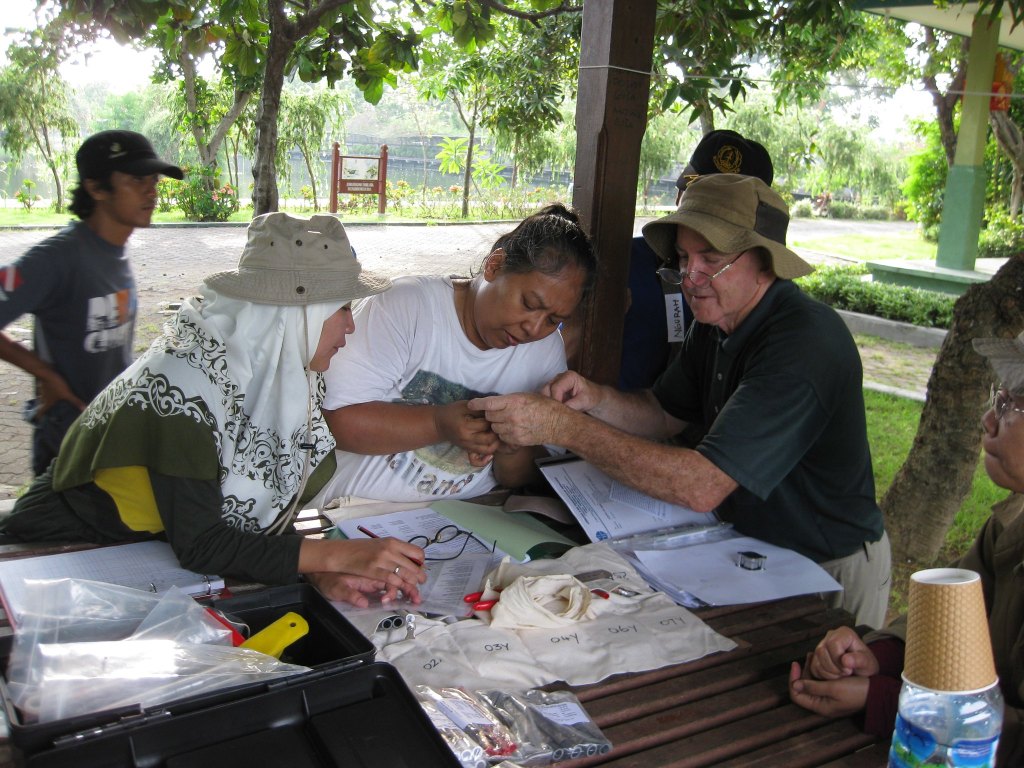
Ok, a few birds for you! Yours truly holding a Pink-necked Green-Pigeon for photographs.

Plain-throated Sunbird

Where’s the ‘plain throat’ on the sunbird, I hear you ask! Here it is…
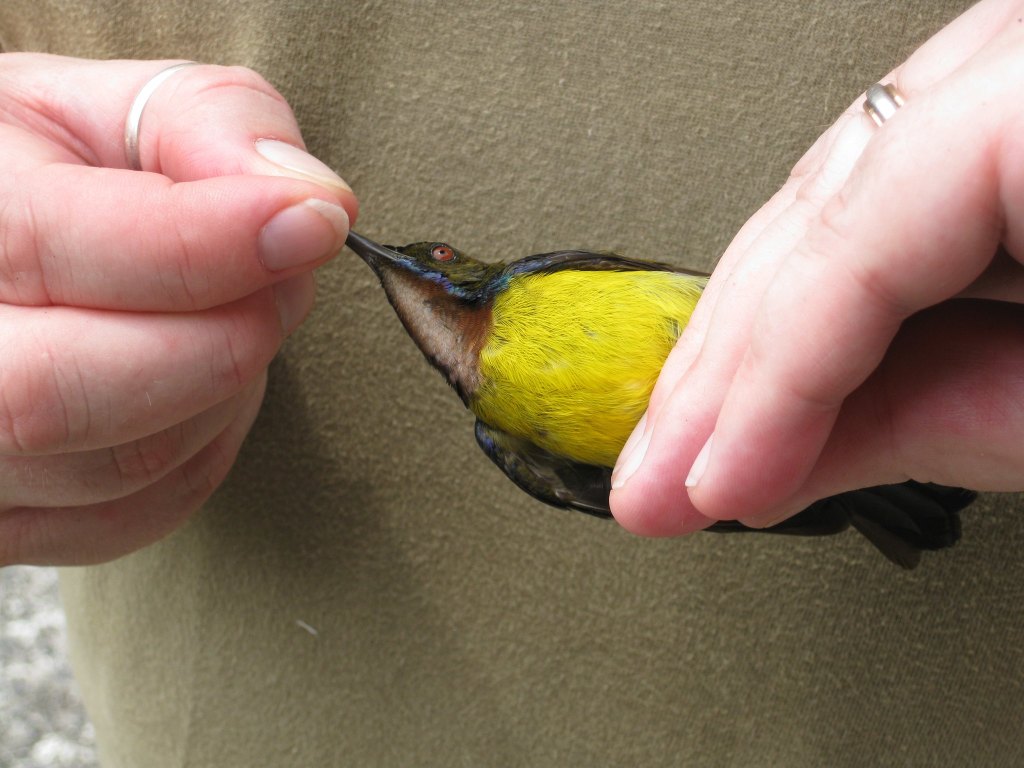
Can you imagine the thought process of Austrian physician and naturalist Giovanni Scolopi when he formally described and named this species in 1786?? Possibly along these lines … “Hmmm, here I have a sunbird, with iridescent green, bronze, purple and indigo on the back, and a bright yellow belly. What a flashy show off! I think I’ll name it after it’s most boring bit. I declare this the plain-throated sunbird!!” Maybe? Maybe not?
I digress. Onto more birds.
Striated Heron.
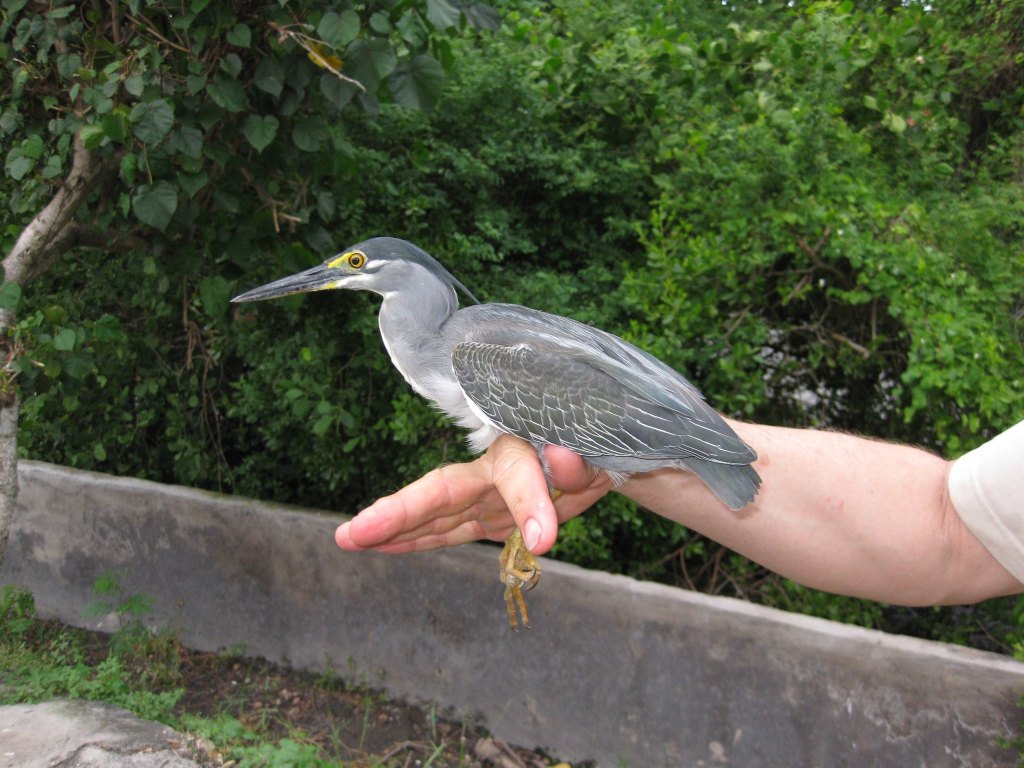
Olive-backed Tailorbird. These cool little birds get their name from the way they construct their nests. They pierce the edges of large leaves and sew them together with plant fibre or spider web to make a cradle in which a grass nest is built.

We did spend a day at some nearby open country where we caught some interesting birds including the two below.
Savanna Nightjar.

Chestnut-headed Bee-eater.

Moving over to the west of the island of Bali, we set ourselves up in the small town of Gilimanuk. The town is at the western tip of the island and only four kilometres from the island of Java. The town is essentially surrounded by Bali Barat National Park.
Some very interesting birds for us all to see in the hand.
The tiny, but stunning, Rufous-backed Kingfisher.

Javan Barred Owlet.

Banded Pitta (yes, we banded an unbanded Banded Pitta!).

It was quite humid in the jungle, and a day’s field work was very draining. Much water was consumed! Below is a snap of the guys after a long day.

However, nothing perks up a weary researcher more than a good meal. Away from the tourist traps of Denpasar, we ate some wonderful local food from tiny cafes. The photo below shows a typical meal box with rice, chili chicken, tofu, peanut curry, vegetables, a banana and some water.

Our trip to Bali was complete. We packed up, said farewell to the trainees and made our way home.

Sulawesi
The third trip to Indonesia, my second, was to the island of Sulawesi. Apparently I performed so well on the trip to Bali, I got invited back!
Our aim for the Sulawesi trip was to work in Lore Lindu National Park. We stayed at a small hotel in the settlement of Wuasa.
Below, Dave is pointing out the book ‘Birds of Lore Lindu National Park’. Either that, or he is extremely happy to have found the hotel’s stash of beer. You choose!

A quick aside. I loved this guy! Just about anything is sold from the back of a motorcycle in Indonesia.

We spent some time banding birds around the hotel itself. There were plenty of birds around, and the idea was to get a lot of captures for the trainees to work on.
Below, a trainee is untying the shelf strings of a mist net, while the other two trainees prepare the pole and guy ropes. A well packed mist net has the four lower shelf strings tied in order onto the white top shelf string; they go on in order, they should come off in order. This avoids getting the whole thing tangled, saving precious time in the field.

The photo below shows the mist net open and ready to catch birds in the front garden at the hotel. Can’t really see the fine nylon mesh net?? That’s the idea. The birds can’t see it either.

We set up a dozen nets in the woodland, forest and plantation around the hotel and had the banding table on the hotel’s front veranda.
Below, Mark is teaching a trainee the fine art of measuring a bird, this time taking the tail length measurement of a Lemon-bellied White-eye. Again, everything required to process a bird is on the table: a gauge for measuring leg diameter, strings of bands, pliers, spring balance, calipers and rulers. The scribe is recording the data as the bander calls it out.

A snap below of said White-eye!

Below, another species of White-eye, this time it’s the Black-crowned.

The Crimson Sunbird, below, was one of the most beautiful birds I’ve seen in the hand!
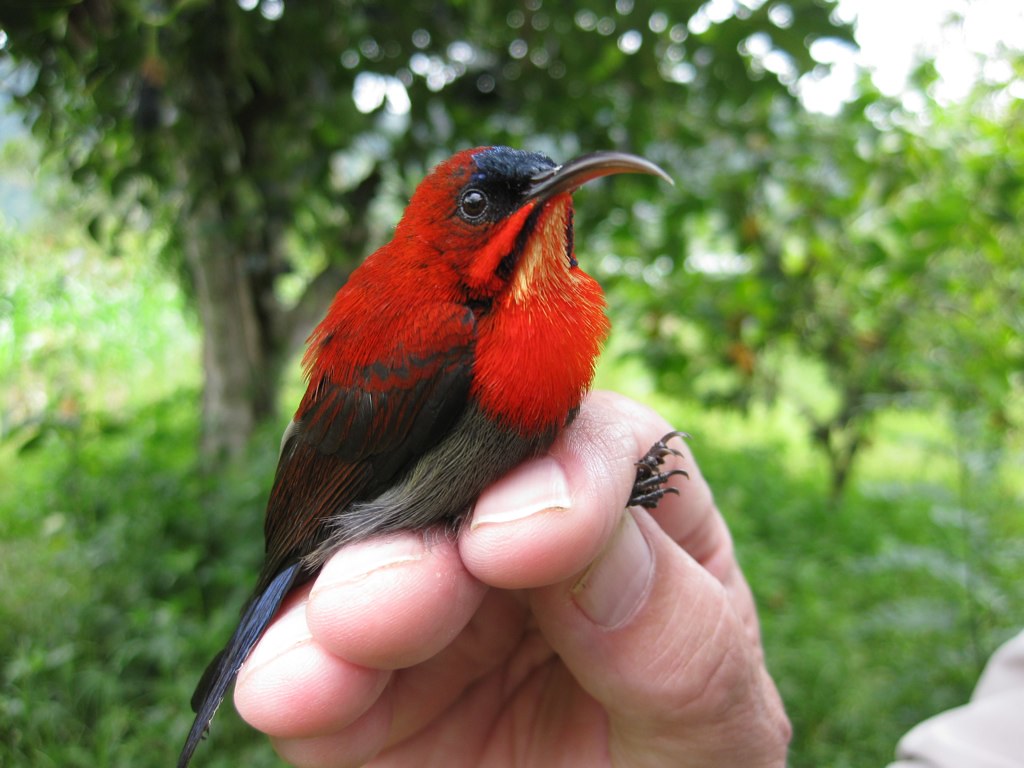
Ok, onto the national park, a 20 minute drive up into the range. The park covers 2,180 square kilometres, and features lowland and montane forests, ranging from 200 to 2,610 metres above sea level. The park, home to 77 bird species endemic to Sulawesi, is part of the UNESCO World Network of Biosphere Reserves. Below is a shot of a path through the forest where we worked, at an altitude of around 1,200 metres.

Necessity is the mother of invention. A makeshift banding station is thrown together with chairs from the hotel, and an old door found in the tiny disused ranger station.

Our host at Hotel Sendy in Wuasa was amazing. She brought lunch up to us in the forest. A big pot of rice, stackable containers with fried chicken, tempeh, stir-fried beans, and fish curry. Two little bags of sambal were opened onto the lid. The green sambal was delicious, but one of the hottest things I’ve ever eaten! Oh, and a large thermos of tea!

Just quickly, while on the subject of food, we were served a spectacular meal each evening at the hotel. In the photo below we had soup with pumpkin and coconut milk, vegetable omelette, stir-fried greens, satay beef and rice.

Most evenings after dinner, we held short discussion sessions about bird banding, data collection and analysis, design and implementation of research projects, publishing data and other relevant topics.
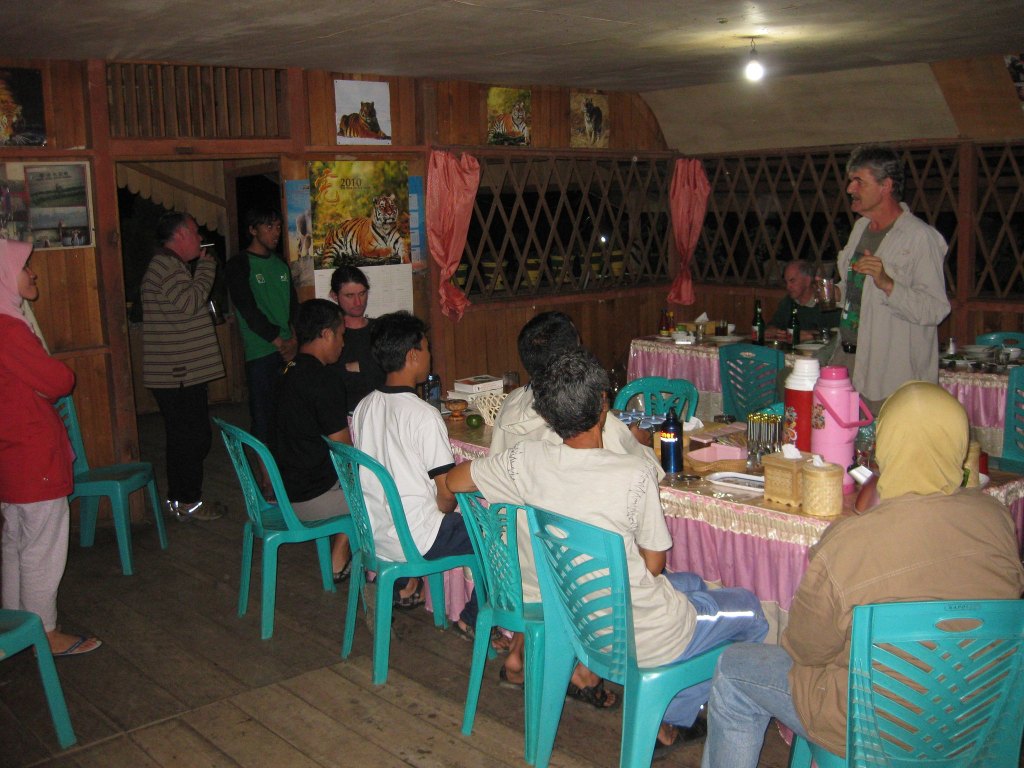
Each day of the trip, we climbed into the mountains to get to our banding site. This was the view of Wuasa as we drove up the range.
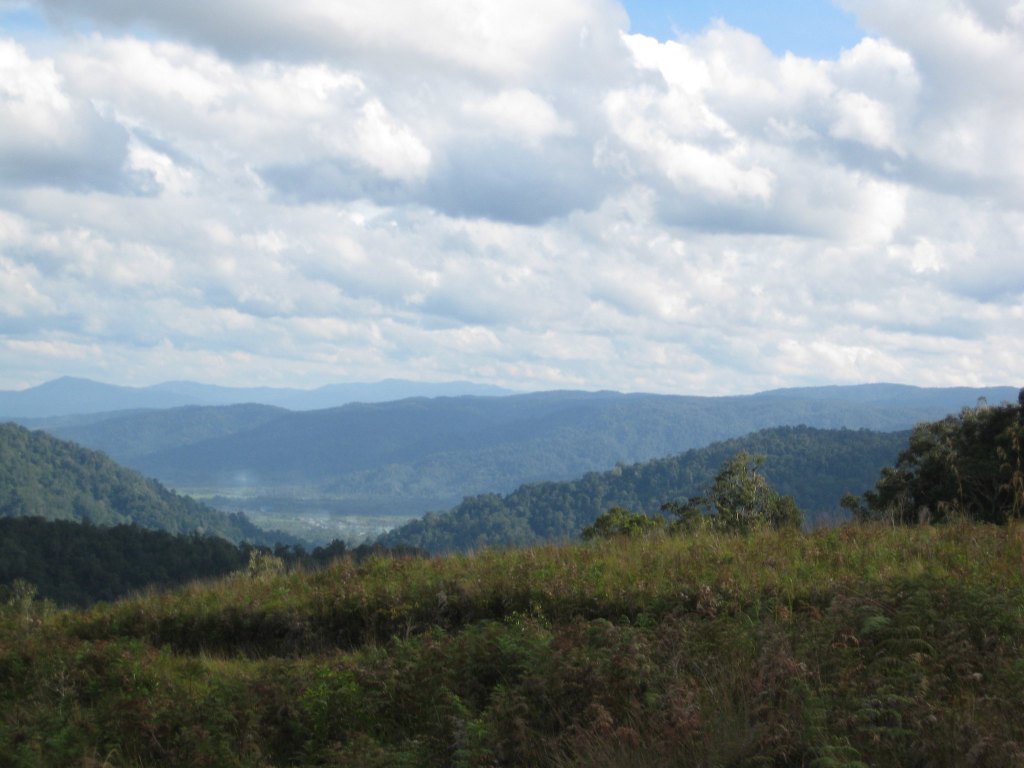
A stop on the way up the range, where we saw Knobbed Hornbills up in the distant rainforest canopy. We also got a decent look at a Tonkean Black Macaque.

Unfortunately, forest clearing still continues at a rapid rate in many parts of Indonesia. The photo below shows clearing of steep slopes so the locals can grow coffee and cacao. Often, the clearing goes right up to the edge of the park.

Right, back to the birds!
Below is a Mountain Tailorbird and a recently fledged Rusty-breasted Cuckoo that we caught in a net together. We assumed that the tailorbird was the host parent of the cuckoo, so released the two birds together after they were banded.

Sulawesi Blue-fronted Flycatcher.

Sulawesi Leaf-warbler.

A closer look at a band being placed around the leg of a Lesser Sulawesi Honeyeater.

Lesser Sulawesi Honeyeater has its photo taken.

A beautiful, tiny little bird, the Little Pied Flycatcher.

Yellow-vented Whistler.
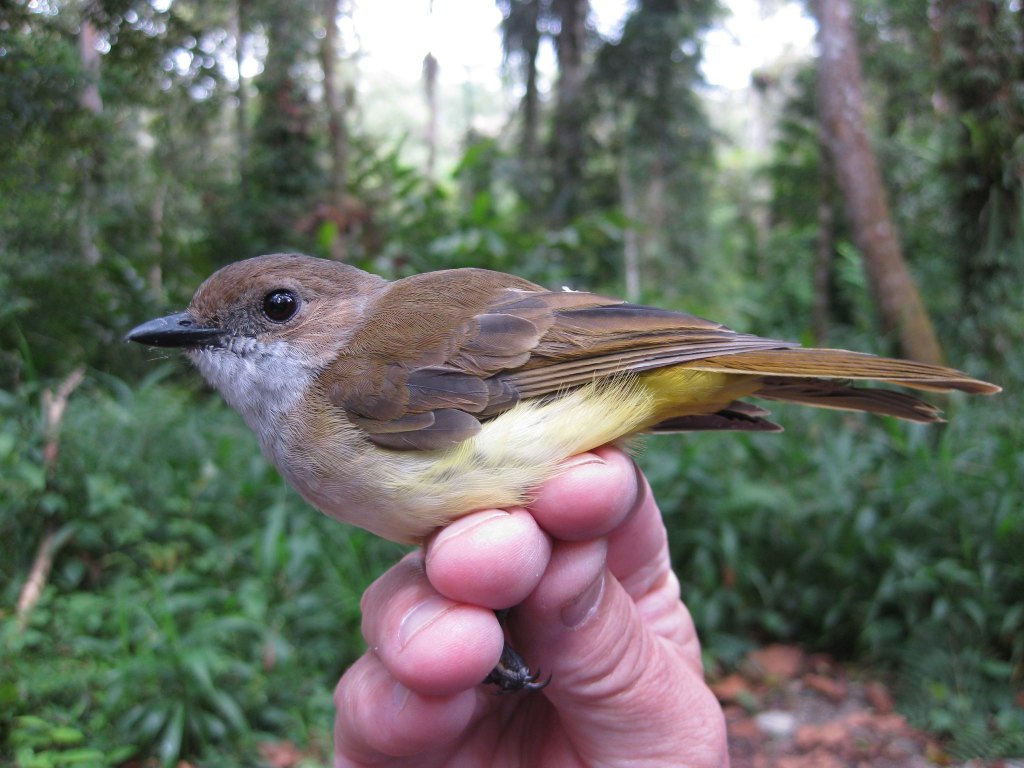
Yellow-flanked Whistler. Look at that eye!!

One of my favourites, the Snowy-browed Flycatcher.
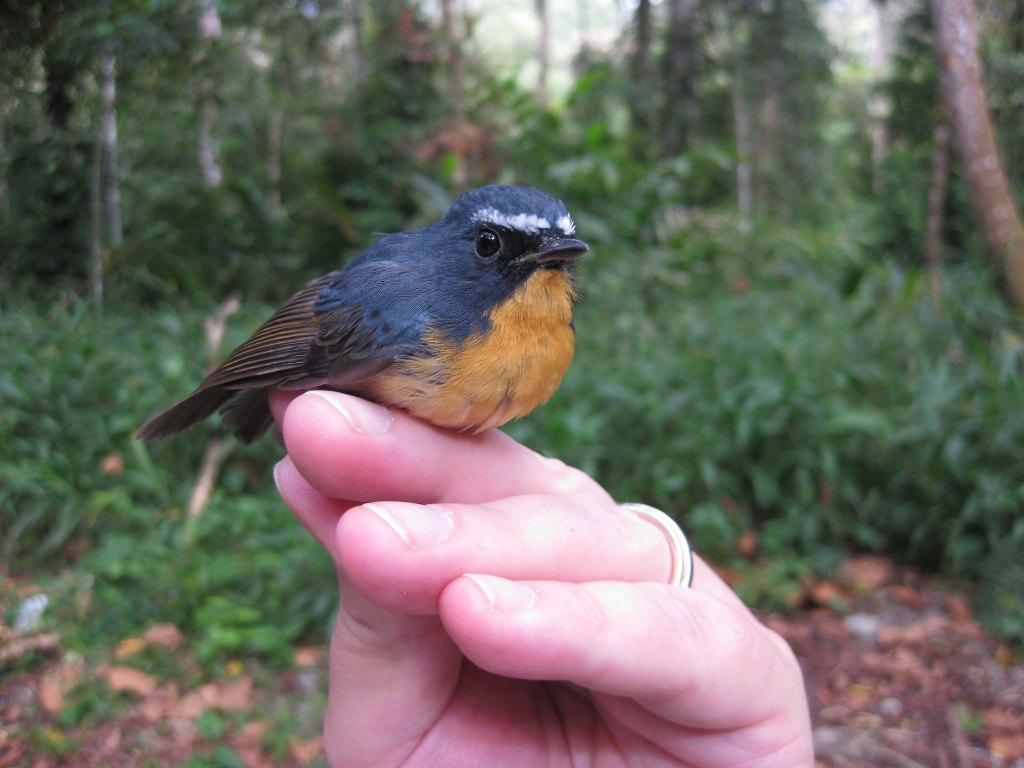
Me holding said flycatcher for other photographers.
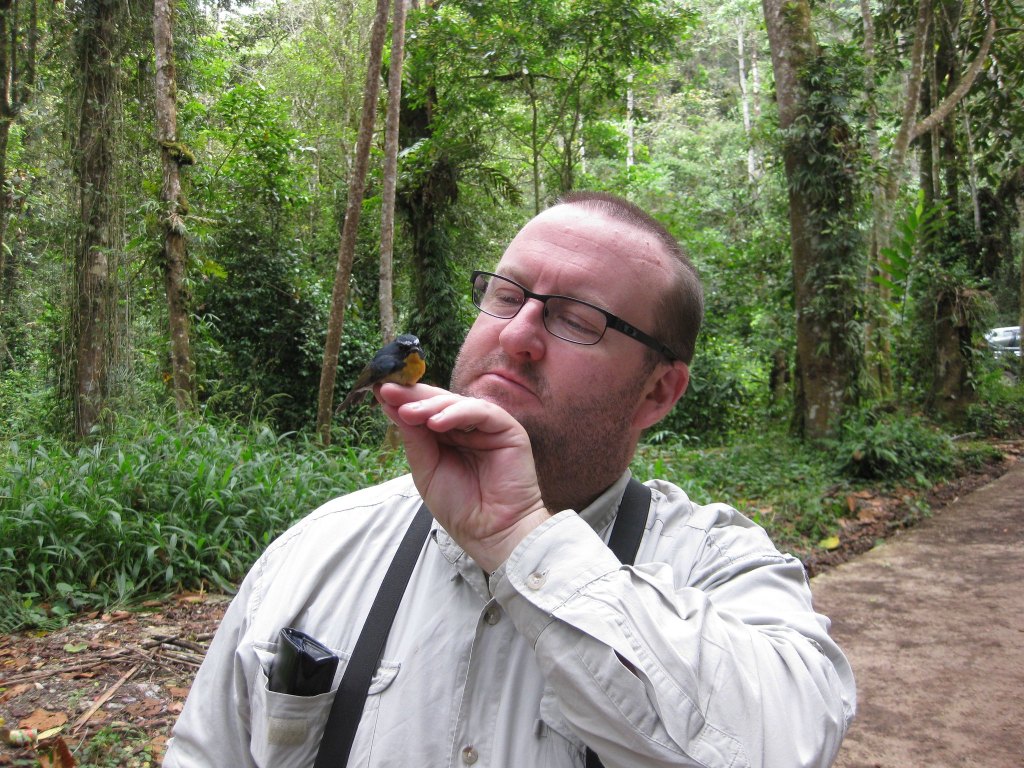
A shot of the ‘A’ team (I neglected to get a shot of the ‘B’ team … )

And that’s the end of my second trip to Indonesia!
Five trips were undertaken for the project, and I felt privileged to be able to participate in two. A total of 37 ornithological researchers were trained during the trips. A couple of the trainees were fortunate enough to go on two trips.
The Indonesian Bird Banding Scheme was established, databases setup, and equipment purchased. The Indonesian scheme still works closely with the ABBBS.
I was pleased to be able to teach other people the skills I had gained over the previous 15 years. It was occasionally quite challenging to transfer substantial knowledge and experience to trainees with little or no experience, and in a very short period of time. The exercise was just that little bit more challenging due to language and cultural differences. You could say that I gained a great deal of experience in international relations as a representative of my government and my country! We all got there in the end, and everyone had a great time doing it!
I was very fortunate to be be able to contribute to the delivery of a significant Australian Government project, which involved doing something that I love. My heartfelt thanks go to Dave and Mark for their support and faith in me!
Anthony Overs
Canberra, Australia
Thanks Anthony, I’m enjoying these (well, especially the birds one, it’d be fair to say that our musical interests intersect only tangentially, at the most optimistic). You write well, tell a good story and take excellent pics. I remember this story from Mark, but not sure that I knew you were involved; great experiences! I’ve been responding to the emails alerting me, but assumed they were from you, so my messages are still floating somewhere in a parallel universe. Cheers Ian
LikeLiked by 1 person
Ha! I’ve not seen any messages, just your post comments! Your responses must be cruising through space somewhere (just like the Star Wars intro words!!).
Thanks so much for your comments, I like the feedback. Happy for you to be brutally honest. Sometimes I think my writing is simple or naive. I can tell a yarn though!
It was Mark’s inability to go on the second trip that prompted him and Dave to get me on board. I was thrilled to have the opportunity. And to be invited back was special.
Re the music posts, I reckon they’re also good stories to tell, even if tastes vary!
Ideas and words are coming thick and fast, I’m enjoying writing again. It is two years ago today that I retired, with those last months of work absolutely hating writing and not being able to do it well.
LikeLike
Maybe I should continue this ‘off line’, but I’m here now. Having written the previous I read your post about Elliott and his 8yo band experience. I loved it, it really was an excellent story and the nature of the music was irrelevant to it.
Writing is essential to my well-being, like being in the bush. It’s my only creative outlet (well, plus cooking perhaps); the idea of creating music or art is completely impenetrable to me, I wouldn’t know how to start. And there’s nothing with wrong with writing simply, quite the contrary. Do you know Orwell’s six rules for plain prose? I have them stuck above my keyboard as a constant reminder. Worth looking them up (though I’m not suggesting you need them!). Keep it up and I look forward to more.
LikeLike